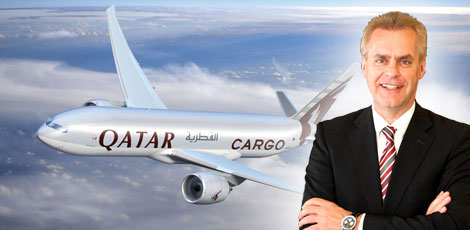Qatar Airways Cargo surges ahead
25 / 01 / 2014

WHEN he was chief executive of Cargolux you might have said that Ulrich Ogiermann had the dream job in air cargo. But now that he is chief officer, cargo, for Qatar Airways, a role he took up in November 2012, he is arguably in an even more exciting position.
At a time when cargo growth at many airlines is static or in decline, with freighter fleets being abandoned or cut, Qatar Airways is surging ahead on all fronts, and making big investments in both its cargo and passenger fleet.
“There is a completely different feeling in this part of the world,” Ogiermann says. “When I go to Europe it is all about trimming the business, reducing the cost base. But here it is about growth and putting the infrastructure in place to cope with it. So it is obviously very enjoyable to work in this environment.”
Qatar Airways Cargo currently serves 133 bellyhold destinations and 40 freighter ones. And counting. With a fleet of 128 aircraft and a new one arriving every 12 days on average, it is aiming for a fleet of nearly 200 aircraft in less than three years. That means the cargo team is kept busy opening up new markets, exploring new territory.
But how does it manage to fill all the new capacity and achieve double-digit growth, when the rest of the air cargo business – even the once rapidly-expanding Far Eastern carriers – are stagnant or even declining?
Ogiermann says there is no magic secret. “We are in the same market. We deal with the same forwarders and the same global accounts. Basically it boils down to being more competitive – on products, quality and prices – and maintaining positive interactions with our clients.”
As an example he cites perishables, where Qatar Airways has just invested in 30 new cool-trucks that pick up perishable shipments directly from the aircraft, or even sit on the tarmac keeping the cargo cold if the connection time is less than two or three hours.
Ogiermann says it is the only Middle Eastern carrier with such a capability, citing his own perishables manager – a former supply chain manager for renowned UK retailer Marks & Spencer – as saying it is the only carrier in the region to guarantee complete temperature control during transfers. This has opened up markets such as the transport of fruit, vegetables and flowers from Africa to Europe and the transport of fish from Europe to Asia.
Qatar has its geographical advantages, of course. “Having a hub in this location means that we can optimise flights on each different sector – the Indian Subcontinent, Asia and Africa,” Ogiermann says. “Loads are more balanced because we have a feeding/de-feeding point in the middle. We don’t have to hop around to different destinations on route, chasing cargo on the way.”
Read Peter Conway’s full interview in the next edition of Air Cargo News 27 January 2014 – Issue 769














